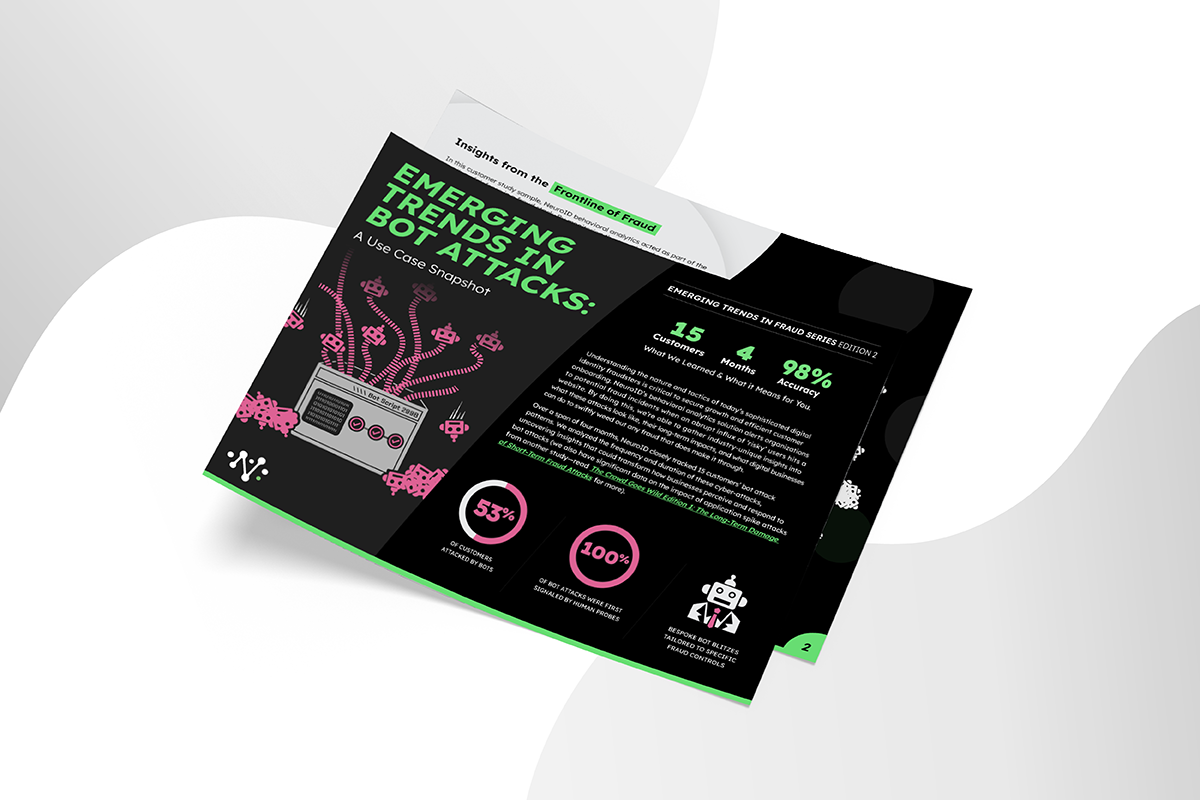
2 Truths and a Lie about Bot-Led Fraud Attacks
Bots used to be mundane, easily identified programs of scraped data, spam attempts, and automated “human imposter” patterns. But as their actual human generals leverage increasingly accessible genAI and automation tools, bot armies have become more sophisticated and aggressive: in just the previous 15 months prior to June 2023, more than 5 trillion malicious bot attacks were reported across the ecommerce universe. Bots can now commandeer user accounts, execute formidable DDoS assaults, exploit APIs, and more.
Through a four month bot analysis, NeuroID has seen these trends firsthand. 53% of observed customers were attacked by advanced bots tailored to target their defenses. It will always be a challenge to stay ahead of the rapidly evolving bot landscape—but being aware of the facts (and myths) surrounding malicious bots is the first step to building a strong defense against them.
Truth 1: Bots Are Smart. Really, Really Smart.
Bots are no longer mindless mercenaries deployed to attack solely with brute force. Modern bot attacks have evolved into intricate threats backed by human brain power, blending bot efficiency with human intelligence to create highly developed, strategic attacks that overpower traditional defenses.
A NeuroID study found that 100% of observed bot attacks were meticulously preceded by human testing. Human fraudsters act as scouts, carefully evaluating and probing defenses, identifying weak points within their target’s fraud stacks. Then, they mobilize their bot armies to exploit these vulnerabilities. This human-bot tag-team effort yields tailored attacks that adapt quickly, often outpacing and overpowering defenders’ ability to detect and counteract them.
This is a concerningly clear trend when it comes to bots: they’re only getting smarter. Fraudsters have harnessed GenAI, or generative artificial intelligence, to enhance the scale and precision of bot-driven attacks. Powered by dark web programs like FraudGPT and WormGPT, AI-driven bots are adept at manipulating security protocols and mimicking human behavior, enabling them to bypass traditional security systems with alarming ease. Without a system that can monitor and detect bot activity in real-time, these bots go unnoticed and cause significant damage.
Truth 2: Stop One Bot, Two More Attack in Its Place
Fighting modern bot attacks is a lot like battling a hydra, the mythical serpent that grew back two heads for each one severed. Just like the hydra grew two heads when one was cut off, today’s bots multiply in force and sophistication whenever one avenue of attack is stopped. In a scenario observed by NeuroID, as a customer tightened controls to stop one attack, bots targeted another product onboarding session with different controls. Fraudsters were aware of multiple points of entry and planned ahead to strategically move across them all, creating a dynamic, dangerous scenario.
As a result, addressing just a single point of attack isn’t enough. In fact, relying solely on escalating friction for risky users can give fraudsters even more ammunition to attack with: human probes purposely trigger step-up fraud defenses, finding out what each layer of security consists of and how to circumvent it. These attacks often constitute a series of coordinated hits, making them incredibly difficult to anticipate and defend against.
A successful defense against modern bot attacks needs a multi-faceted strategy that’s ready to adapt and respond effectively to evolving threats. To counter these attacks, you’ll need a solution that can monitor traffic in real-time and effectively weed out bots.
The Big Lie: Bots Are Unbeatable.
We’ve painted a grim picture. And it’s an accurate one: as the modus operandi of bots evolves, with bots sometimes showing a higher success rate in completing application processes than genuine users, the stakes are higher than ever. It’s a scenario that demands attention and action.
As bots grow wiser and more pervasive, the cat-and-mouse game between defenders and attackers is only set to intensify. The challenge for businesses lies not just in understanding and countering bot strategies but also in staying ahead of the curve in the fight against sophisticated bots.
With NeuroID’s behavioral analytics, businesses are equipped with effective defenses against these threats. By placing behavioral analytics at the top of their fraud stack, businesses are equipped with a scalable, multi-layered defense that can protect against bots’ evolution, speed, and agility in real-time.



